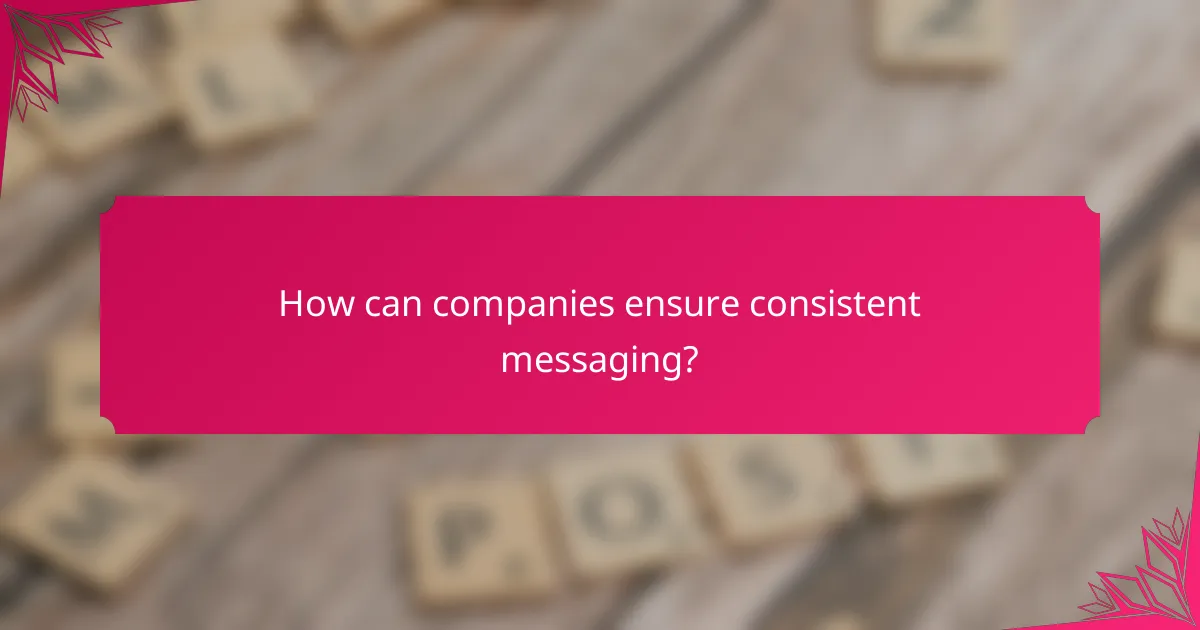In today’s competitive landscape, businesses must navigate content saturation by implementing targeted strategies that prioritize relevance and engagement. Consistent messaging is crucial for maintaining brand credibility, as inconsistency can alienate audiences and weaken overall impact. By establishing clear communication guidelines and a unified brand voice, companies can effectively stand out and connect with their target market.

How can businesses overcome content saturation in the UK?
Businesses in the UK can overcome content saturation by focusing on targeted strategies that enhance relevance and engagement. By refining their messaging and leveraging unique content, companies can stand out in a crowded marketplace.
Implement targeted audience segmentation
Targeted audience segmentation involves dividing your audience into specific groups based on demographics, interests, or behaviors. This allows businesses to tailor their content to meet the unique needs of each segment, increasing engagement and reducing saturation. For instance, a fashion retailer might segment their audience by age and style preference, creating distinct campaigns for each group.
To effectively segment your audience, utilize tools like surveys, analytics, and social media insights. Regularly update your segments to reflect changes in consumer behavior and preferences.
Focus on niche content creation
Creating niche content means developing specialized topics that cater to specific interests within your target audience. This approach helps businesses differentiate themselves from competitors and attract a dedicated following. For example, a tech company could focus on sustainable technology solutions, appealing to environmentally conscious consumers.
When producing niche content, ensure it is informative and valuable. Consider using expert opinions, case studies, or in-depth guides to establish authority and trust within your niche.
Utilize data-driven content strategies
Data-driven content strategies involve using analytics to inform content creation and distribution. By analyzing performance metrics, businesses can identify what resonates with their audience and adjust their strategies accordingly. For example, monitoring engagement rates can help determine which topics generate the most interest.
Employ tools like Google Analytics or social media insights to gather data on user behavior. Regularly review this data to refine your content strategy and optimize future campaigns.
Leverage user-generated content
User-generated content (UGC) is any content created by consumers about a brand, such as reviews, testimonials, or social media posts. UGC not only enhances authenticity but also fosters community engagement. For instance, a travel company might encourage customers to share their travel experiences, showcasing real-life adventures.
To effectively leverage UGC, create campaigns that encourage sharing, such as contests or hashtags. Always seek permission to use this content and give credit to the original creators to build trust and loyalty.
Optimize content distribution channels
Optimizing content distribution channels means selecting the most effective platforms to share your content. This ensures that your messaging reaches the right audience without getting lost in the noise. Consider using a mix of social media, email marketing, and SEO to maximize visibility.
Evaluate the performance of each channel regularly. Focus on those that yield the highest engagement rates and consider investing in paid promotions for underperforming content to enhance reach.

What are the impacts of inconsistent messaging?
Inconsistent messaging can significantly undermine a brand’s credibility and effectiveness. When a brand fails to present a unified message, it risks alienating its audience and diluting its overall impact.
Decreased brand trust
Inconsistent messaging leads to decreased brand trust as consumers become skeptical of the brand’s reliability. When messages vary across platforms or campaigns, audiences may question the authenticity and integrity of the brand.
To maintain trust, ensure that all communications align with core brand values and messaging guidelines. Regular audits of marketing materials can help identify discrepancies and reinforce a cohesive narrative.
Confusion among target audiences
Confusion arises when target audiences receive mixed signals from a brand. This can result in misunderstandings about product offerings, brand values, or even pricing structures.
To avoid confusion, create a clear messaging framework that outlines key messages for different segments of your audience. Utilize consistent terminology and visuals across all channels to reinforce understanding.
Lower engagement rates
Lower engagement rates are a common consequence of inconsistent messaging. When audiences are confused or distrustful, they are less likely to interact with content, leading to diminished reach and impact.
To enhance engagement, focus on delivering a consistent message that resonates with your audience’s needs and preferences. Regularly analyze engagement metrics to identify trends and adjust your strategy accordingly.

How can companies ensure consistent messaging?
Companies can ensure consistent messaging by establishing clear guidelines and regularly reviewing their communication strategies. This involves creating a unified brand voice that resonates across all platforms and touchpoints.
Develop a comprehensive brand style guide
A brand style guide is essential for maintaining consistent messaging. It should outline key elements such as tone, language, visual identity, and messaging frameworks. This guide serves as a reference for all team members, ensuring that everyone communicates in alignment with the brand’s values.
Include examples of preferred phrases, logo usage, and color schemes to provide clarity. Regular updates to the style guide can help adapt to evolving market trends while retaining core messaging principles.
Conduct regular messaging audits
Regular messaging audits help identify inconsistencies in communication across different channels. By reviewing content periodically, companies can assess whether their messaging aligns with the brand’s objectives and resonates with the target audience.
Consider using a checklist that includes evaluating tone, clarity, and relevance of messages. This process can reveal gaps or overlaps in messaging, allowing for adjustments that enhance overall coherence.
Train team members on brand voice
Training team members on the brand voice is crucial for ensuring consistent messaging. Conduct workshops or training sessions that emphasize the importance of the brand’s tone and style, and provide practical exercises to reinforce these concepts.
Encourage team members to practice writing and speaking in the brand voice, offering feedback to refine their skills. This investment in training fosters a unified approach to communication, which can significantly enhance brand perception.

What resource demands should be considered in content marketing?
In content marketing, resource demands encompass budget, time, and staffing requirements necessary for effective strategy execution. Understanding these demands helps businesses allocate resources efficiently and maximize their marketing impact.
Budget allocation for content creation
Budget allocation is crucial for content creation as it determines the quality and quantity of materials produced. Businesses should consider costs for tools, software, and potential outsourcing, which can range from a few hundred to several thousand dollars monthly depending on the scale of the operation.
It’s advisable to set aside a percentage of overall marketing budget—typically between 20-40%—for content-related expenses. This ensures that sufficient funds are available for high-quality content that resonates with the target audience.
Time investment for strategy development
Developing a content marketing strategy requires a significant time investment, often spanning weeks to months. This includes research, planning, and execution phases that involve brainstorming ideas, creating content calendars, and analyzing performance metrics.
On average, businesses should expect to dedicate at least 10-20 hours per week for initial strategy development. Regular reviews and updates will also demand ongoing time commitments to ensure the strategy remains relevant and effective.
Staffing needs for content production
Staffing needs for content production can vary widely based on the volume and complexity of content required. Smaller businesses might manage with one or two content creators, while larger organizations may need a dedicated team including writers, editors, and graphic designers.
When assessing staffing, consider the workload and expertise required. Hiring freelancers or agencies can be a flexible solution, allowing businesses to scale resources up or down based on project demands without the long-term commitment of full-time hires.

What frameworks can help in evaluating content marketing strategies?
Frameworks for evaluating content marketing strategies focus on measuring effectiveness and aligning messaging with audience needs. Key frameworks include performance metrics and audience feedback mechanisms, which help identify strengths and weaknesses in your content approach.
Content performance metrics
Content performance metrics are essential for assessing how well your content resonates with your audience. Common metrics include engagement rates, conversion rates, and traffic sources. For example, a blog post that generates high traffic but low conversions may indicate a disconnect between the content and the audience’s needs.
When evaluating these metrics, consider using tools like Google Analytics or social media insights to gather data. Aim for benchmarks such as a 2-5% conversion rate for e-commerce content or a 10-20% engagement rate on social media posts. Regularly review these metrics to adapt your strategy accordingly.
Audience feedback mechanisms
Audience feedback mechanisms provide direct insights into how your content is perceived. Surveys, polls, and comment sections can reveal what resonates with your audience and what does not. For instance, a quick survey after a webinar can help gauge participant satisfaction and areas for improvement.
Implementing feedback loops is crucial; consider setting up regular check-ins or feedback forms to capture audience opinions. Aim for a response rate of 10-15% for surveys to ensure you gather meaningful data. Use this feedback to refine your messaging and content strategy, ensuring it remains relevant and engaging.

How can emerging technologies enhance content marketing?
Emerging technologies can significantly improve content marketing by enabling more personalized experiences and optimizing resource allocation. Tools like artificial intelligence and machine learning help marketers analyze data and create content that resonates with specific audiences.
AI-driven content personalization
AI-driven content personalization tailors marketing messages to individual user preferences and behaviors. By analyzing data from user interactions, AI can determine what type of content is most likely to engage a specific audience segment.
To implement AI-driven personalization, businesses should invest in data analytics tools that track user behavior across various platforms. This can include website interactions, social media engagement, and email responses. For example, a retail website might recommend products based on a user’s previous purchases or browsing history.
When utilizing AI for content personalization, avoid common pitfalls such as over-segmentation, which can lead to fragmented messaging. Instead, focus on creating a few well-defined audience segments that allow for more coherent and effective communication strategies.
